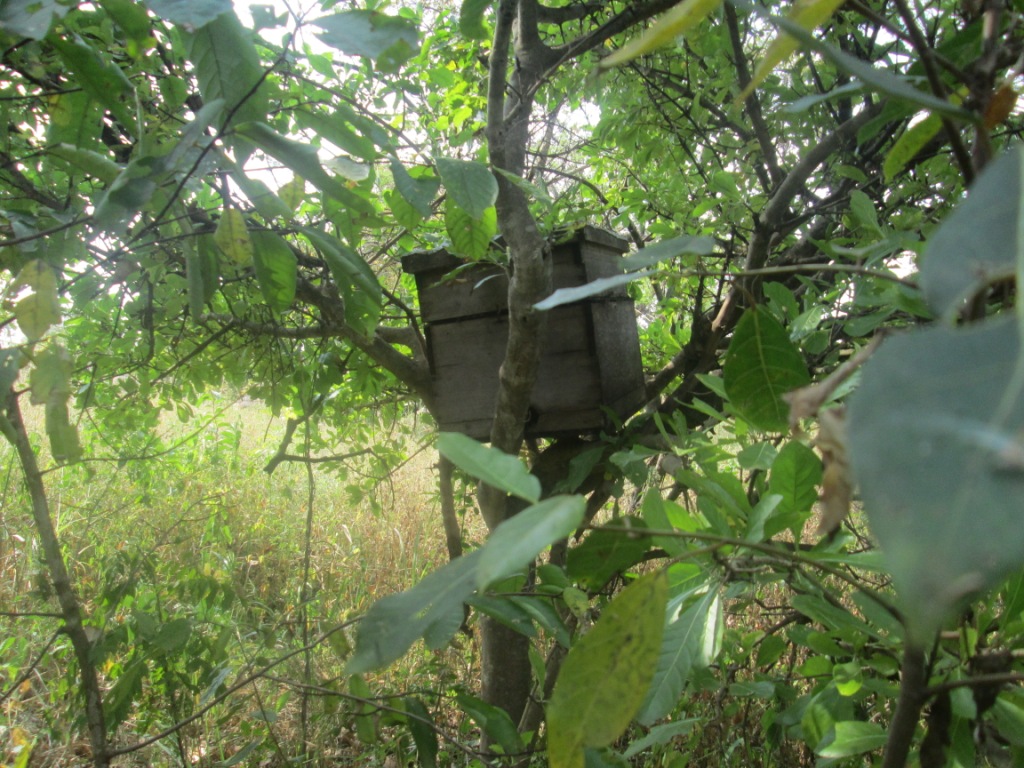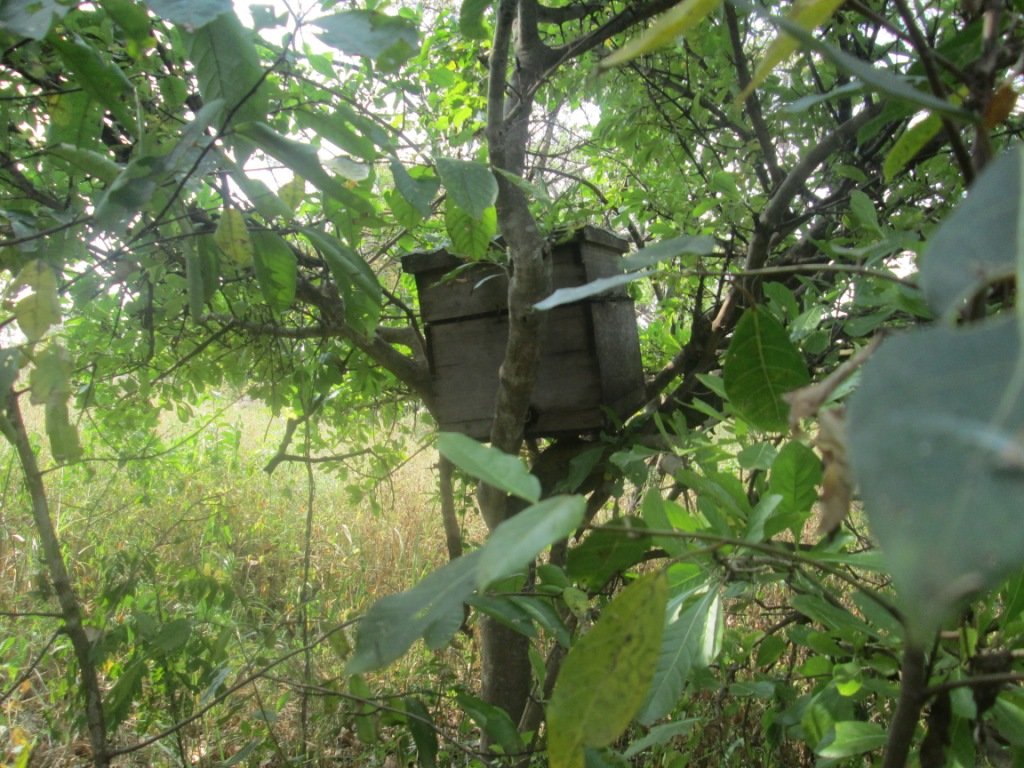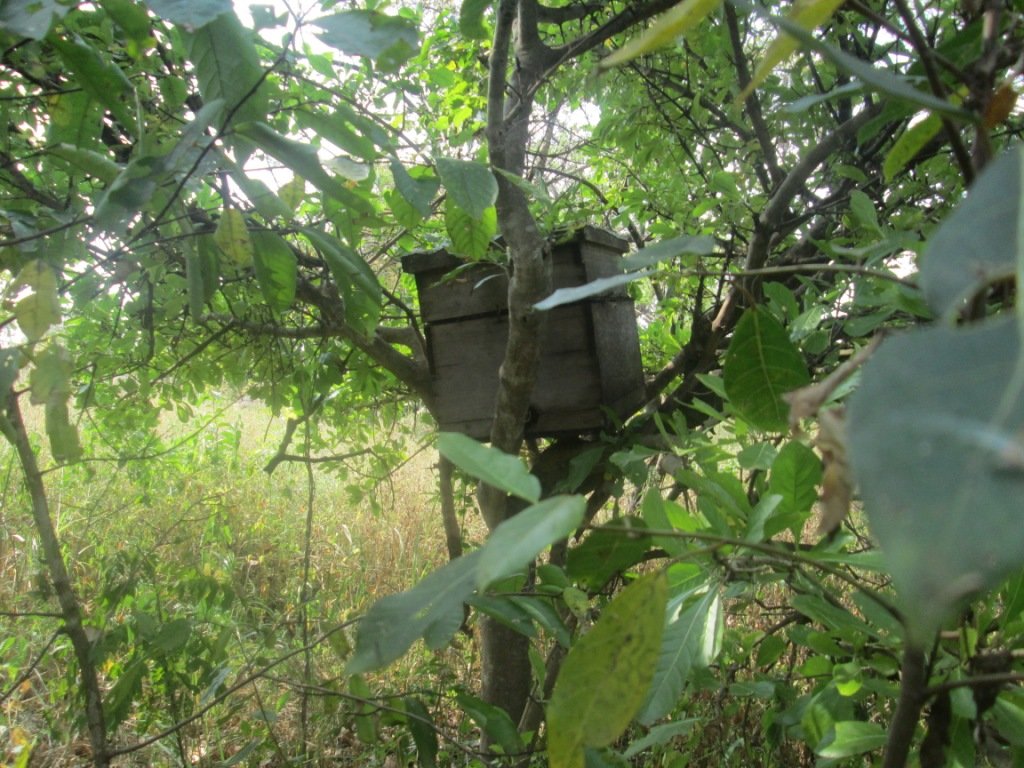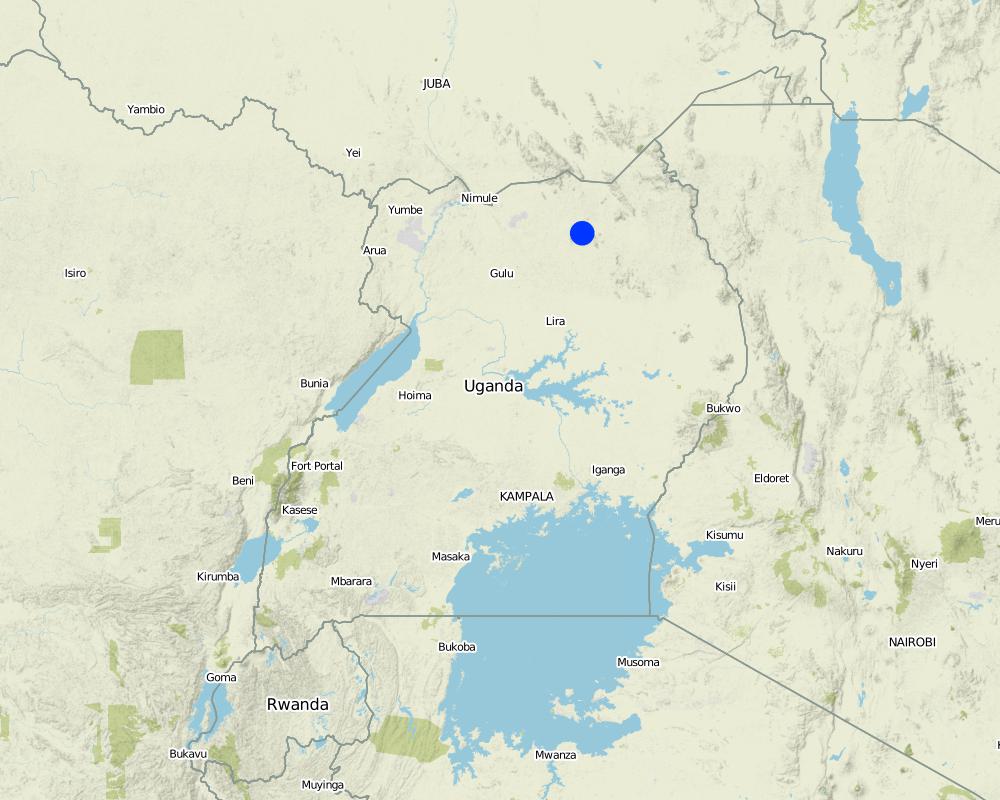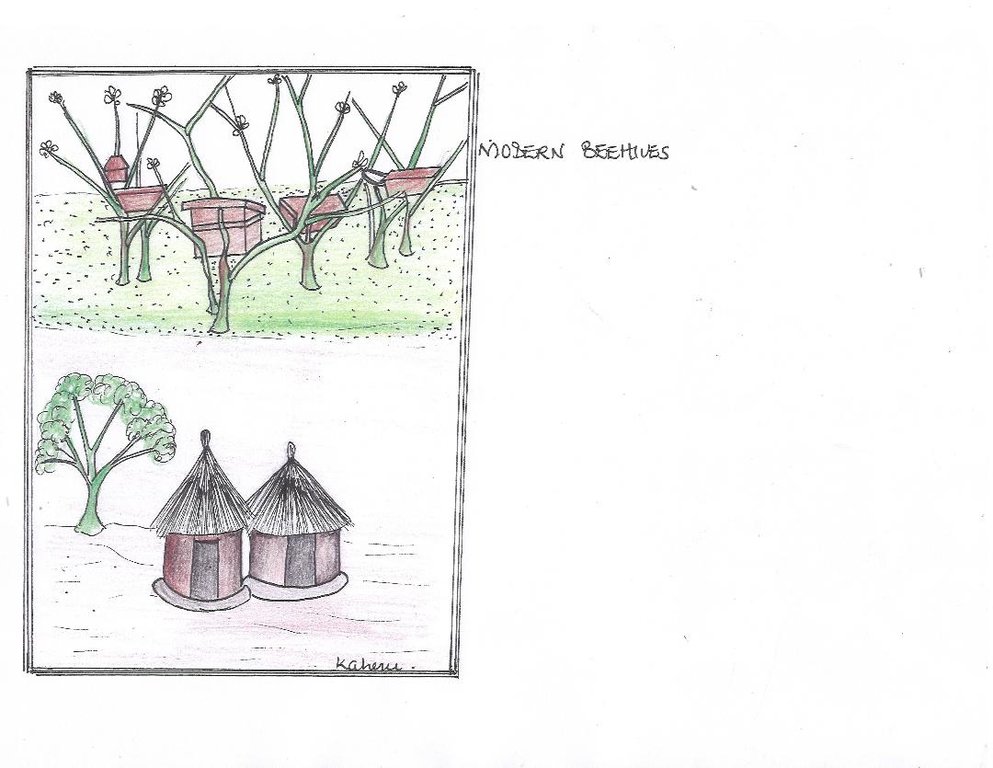Modern Bee Hives based Apiculture [Uganda]
- Creation:
- Update:
- Compiler: Kamugisha Rick Nelson
- Editors: JOY TUKAHIRWA, Richard Otto Kawawa, Bernard Fungo, betty adoch
- Reviewers: Drake Mubiru, Nicole Harari, Renate Fleiner, Stephanie Jaquet, Donia Mühlematter
Pito Kil
technologies_2327 - Uganda
View sections
Expand all Collapse all1. General information
1.2 Contact details of resource persons and institutions involved in the assessment and documentation of the Technology
Key resource person(s)
land user:
OKeny Oris
0782595646
ocanbosco@yahoo.com
Kitgum District
Kitgum District
Uganda
Name of project which facilitated the documentation/ evaluation of the Technology (if relevant)
Scaling-up SLM practices by smallholder farmers (IFAD)Name of the institution(s) which facilitated the documentation/ evaluation of the Technology (if relevant)
CDE Centre for Development and Environment (CDE Centre for Development and Environment) - Switzerland1.3 Conditions regarding the use of data documented through WOCAT
When were the data compiled (in the field)?
12/05/2017
The compiler and key resource person(s) accept the conditions regarding the use of data documented through WOCAT:
Ja
1.4 Declaration on sustainability of the described Technology
Is the Technology described here problematic with regard to land degradation, so that it cannot be declared a sustainable land management technology?
Nee
Comments:
The protected vegetation where the bees are installed restores the environment since its not cultivated over and over again.
2. Description of the SLM Technology
2.1 Short description of the Technology
Definition of the Technology:
Modern bee hives are installed on natural trees in order to conserve the environment and provide honey and income.
2.2 Detailed description of the Technology
Description:
Apiculture is a non-problematic enterprise promoted by small-scale farmers. Beehives are hanged by the land user on trees for purposes of conservation and obtaining income from the sale of honey. The technology is located on a gentle slope (3-5%) of 3 acres of land with 150 bee hives installed. The trees produce flowers from which bees collect nectar to make honey. The activities involved in the establishment include making or acquiring improved beehives, installing the hives, and buying honey-harvesting equipment. In addition, there are maintenance activities which are; the inspection of the hives for damages, repair of damaged hives, periodic harvesting of honey, clearing overgrowth within the apiary and marketing the honey. The inputs required for establishing such a technology include labour for bush clearing, placing the beehives within trees and construction of fire lines. Other inputs are beehives, a bee suit, smoker, bucket, filtering materials and bottles. These inputs require a lot of money. The benefits from this SLM technology are slightly negative due to the high costs of labour at the time of establishment but positive in the long term due to environmental conservation, provision of honey and income from the sale of honey and to some extent reduction in land cover depletion since no cultivation takes place where the bee hives are installed. The bees also play an important role in the well being of the ecosystem through pollinating flowers of plants within their reach.
The technology is easy to manage once established, because it does not require routine activities like weeding, spraying and watering. For other land users who may need to adopt this technology, they need to seek advice from extension agents on how to install the beehives.
2.3 Photos of the Technology
2.4 Videos of the Technology
Comments, short description:
Modern bee hives based apiculture ,Kitgum District, Northern Uganda.
Date:
27/04/2017
Location:
Kitgum District
Name of videographer:
Issa Aiga
2.5 Country/ region/ locations where the Technology has been applied and which are covered by this assessment
Country:
Uganda
Region/ State/ Province:
Northern Region,Uganda
Further specification of location:
Kitgum District
Comments:
Map showing technology site in Northern Uganda.
Map
×2.6 Date of implementation
Indicate year of implementation:
2013
If precise year is not known, indicate approximate date:
- less than 10 years ago (recently)
2.7 Introduction of the Technology
Specify how the Technology was introduced:
- through land users' innovation
- as part of a traditional system (> 50 years)
Comments (type of project, etc.):
The land user started on his own and later he got support with trainings from other development programs e.g. the Northern Uganda Social Action Fund (NUSAF) and Operation Wealth Creation (OWC) / NAADS (National Agricultural Advisory Services).
3. Classification of the SLM Technology
3.1 Main purpose(s) of the Technology
- improve production
- reduce, prevent, restore land degradation
- conserve ecosystem
- adapt to climate change/ extremes and its impacts
- create beneficial economic impact
3.2 Current land use type(s) where the Technology is applied

Forest/ woodlands
(Semi-)natural forests/ woodlands:
- Dead wood/ prunings removal
Products and services:
- Other forest products
- Honey

Mixed (crops/ grazing/ trees), incl. agroforestry
- Agroforestry
3.3 Further information about land use
Water supply for the land on which the Technology is applied:
- rainfed
Number of growing seasons per year:
- 2
Specify:
August and March. Depending on the season.
3.4 SLM group to which the Technology belongs
- agroforestry
- beekeeping, aquaculture, poultry, rabbit farming, silkworm farming, etc.
3.5 Spread of the Technology
Specify the spread of the Technology:
- evenly spread over an area
If the Technology is evenly spread over an area, indicate approximate area covered:
- < 0.1 km2 (10 ha)
Comments:
The land user is utilizing 3 acres of land currently for apiary.
3.6 SLM measures comprising the Technology

structural measures
- S11: Others

management measures
- M2: Change of management/ intensity level
- M3: Layout according to natural and human environment
Comments:
The land user is establishing fire lines to keep away wild bush fires and making regular inspection of bee hives.
3.7 Main types of land degradation addressed by the Technology

biological degradation
- Bc: reduction of vegetation cover
- Bh: loss of habitats
- Bf: detrimental effects of fires
3.8 Prevention, reduction, or restoration of land degradation
Specify the goal of the Technology with regard to land degradation:
- adapt to land degradation
4. Technical specifications, implementation activities, inputs, and costs
4.1 Technical drawing of the Technology
4.2 Technical specifications/ explanations of technical drawing
The technology is installed on a gentle slope (3-5%) located on a 3 acres of land with 150 bee hives.
4.3 General information regarding the calculation of inputs and costs
Specify how costs and inputs were calculated:
- per Technology area
Indicate size and area unit:
3 acres
other/ national currency (specify):
UGX
Indicate exchange rate from USD to local currency (if relevant): 1 USD =:
3400.0
Indicate average wage cost of hired labour per day:
5000 per person per day
4.4 Establishment activities
| Activity | Type of measure | Timing | |
|---|---|---|---|
| 1. | Installing bee hives location | Structural | Once before establishment, |
| 2. | Construction of hives (traditional and modern) | Structural | Before establishment |
| 3. | Place hives on forests or trees | Structural | Before establishment |
4.5 Costs and inputs needed for establishment
| Specify input | Unit | Quantity | Costs per Unit | Total costs per input | % of costs borne by land users | |
|---|---|---|---|---|---|---|
| Labour | Hired labour (installation) | persons | 5.0 | 5000.0 | 25000.0 | |
| Equipment | Bee hives | Pieces | 16.0 | 90000.0 | 1440000.0 | |
| Other | Transport | pick up | 1.0 | 20000.0 | 20000.0 | |
| Total costs for establishment of the Technology | 1485000.0 | |||||
Comments:
Modern hives are more expensive than local hives.
4.6 Maintenance/ recurrent activities
| Activity | Type of measure | Timing/ frequency | |
|---|---|---|---|
| 1. | Clearing around the apiary | Management | Once a year |
| 2. | Hive inspection | Management | After every two weeks |
| 3. | Repair of damaged hives | Structural | Once after 2 years |
| 4. | Regular checking of hives | Management | Regularly |
| 5. | Filter honey from curbs to seprate wax | Management | At the time of harvesting |
4.7 Costs and inputs needed for maintenance/ recurrent activities (per year)
| Specify input | Unit | Quantity | Costs per Unit | Total costs per input | % of costs borne by land users | |
|---|---|---|---|---|---|---|
| Labour | Hired labour | persons | 5.0 | 5000.0 | 25000.0 | |
| Equipment | Timber | Pieces | 2.0 | 10000.0 | 20000.0 | |
| Equipment | Nails | kgs | 2.0 | 7000.0 | 14000.0 | |
| Equipment | Wires | kgs | 100.0 | 2000.0 | 200000.0 | |
| Equipment | buckets | Pieces | 5.0 | 15000.0 | 75000.0 | |
| Total costs for maintenance of the Technology | 334000.0 | |||||
4.8 Most important factors affecting the costs
Describe the most determinate factors affecting the costs:
Modern bee hives are the most expensive and the costs of labour.
5. Natural and human environment
5.1 Climate
Annual rainfall
- < 250 mm
- 251-500 mm
- 501-750 mm
- 751-1,000 mm
- 1,001-1,500 mm
- 1,501-2,000 mm
- 2,001-3,000 mm
- 3,001-4,000 mm
- > 4,000 mm
Specify average annual rainfall (if known), in mm:
1350.00
Agro-climatic zone
- sub-humid
5.2 Topography
Slopes on average:
- flat (0-2%)
- gentle (3-5%)
- moderate (6-10%)
- rolling (11-15%)
- hilly (16-30%)
- steep (31-60%)
- very steep (>60%)
Landforms:
- plateau/plains
- ridges
- mountain slopes
- hill slopes
- footslopes
- valley floors
Altitudinal zone:
- 0-100 m a.s.l.
- 101-500 m a.s.l.
- 501-1,000 m a.s.l.
- 1,001-1,500 m a.s.l.
- 1,501-2,000 m a.s.l.
- 2,001-2,500 m a.s.l.
- 2,501-3,000 m a.s.l.
- 3,001-4,000 m a.s.l.
- > 4,000 m a.s.l.
Indicate if the Technology is specifically applied in:
- concave situations
5.3 Soils
Soil depth on average:
- very shallow (0-20 cm)
- shallow (21-50 cm)
- moderately deep (51-80 cm)
- deep (81-120 cm)
- very deep (> 120 cm)
Soil texture (topsoil):
- medium (loamy, silty)
Soil texture (> 20 cm below surface):
- medium (loamy, silty)
- fine/ heavy (clay)
Topsoil organic matter:
- medium (1-3%)
5.4 Water availability and quality
Ground water table:
< 5 m
Availability of surface water:
medium
Water quality (untreated):
good drinking water
Is water salinity a problem?
Nee
Is flooding of the area occurring?
Nee
Comments and further specifications on water quality and quantity:
The quality is good: land user uses bore hole water.
5.5 Biodiversity
Species diversity:
- low
Habitat diversity:
- low
5.6 Characteristics of land users applying the Technology
Sedentary or nomadic:
- Sedentary
Market orientation of production system:
- mixed (subsistence/ commercial
Off-farm income:
- less than 10% of all income
Relative level of wealth:
- average
Individuals or groups:
- individual/ household
- groups/ community
Level of mechanization:
- manual work
Gender:
- men
Age of land users:
- middle-aged
- elderly
Indicate other relevant characteristics of the land users:
The land user is a hard working farmer and he is planning to plant trees in addition to the apiary technology and to start livestock (zero grazing) for animal manure production. The land user uses rudimentary tools (hoe, panga) for his agricultural production.
5.7 Average area of land owned or leased by land users applying the Technology
- < 0.5 ha
- 0.5-1 ha
- 1-2 ha
- 2-5 ha
- 5-15 ha
- 15-50 ha
- 50-100 ha
- 100-500 ha
- 500-1,000 ha
- 1,000-10,000 ha
- > 10,000 ha
Is this considered small-, medium- or large-scale (referring to local context)?
- medium-scale
Comments:
The land user has another apiary site which is not near the documented one under this questionare (0.5 acres).
5.8 Land ownership, land use rights, and water use rights
Land ownership:
- individual, not titled
Land use rights:
- individual
Water use rights:
- open access (unorganized)
Comments:
The water is low during the dry season.
5.9 Access to services and infrastructure
health:
- poor
- moderate
- good
education:
- poor
- moderate
- good
technical assistance:
- poor
- moderate
- good
employment (e.g. off-farm):
- poor
- moderate
- good
markets:
- poor
- moderate
- good
energy:
- poor
- moderate
- good
roads and transport:
- poor
- moderate
- good
drinking water and sanitation:
- poor
- moderate
- good
financial services:
- poor
- moderate
- good
- poor
- moderate
- good
6. Impacts and concluding statements
6.1 On-site impacts the Technology has shown
Socio-economic impacts
Production
land management
Comments/ specify:
No roaming animals and the technology allows vegetation growth.
Income and costs
expenses on agricultural inputs
Comments/ specify:
Reduce in the short run but increase in the long run(at the time of harvest)
farm income
Comments/ specify:
Decrease in the short run at the time of establishment and relaised in the long run at the time of harvest.
diversity of income sources
Comments/ specify:
especially at the time of establishment and before harvest
workload
Ecological impacts
Soil
soil moisture
soil cover
Comments/ specify:
Due to litter from the tree leaves.
soil loss
Biodiversity: vegetation, animals
Vegetation cover
Comments/ specify:
No cultivation taking place where the bee hives are cited.
plant diversity
beneficial species
6.2 Off-site impacts the Technology has shown
damage on neighbours' fields
Comments/ specify:
protected.
6.3 Exposure and sensitivity of the Technology to gradual climate change and climate-related extremes/ disasters (as perceived by land users)
Gradual climate change
Gradual climate change
| Season | Type of climatic change/ extreme | How does the Technology cope with it? | |
|---|---|---|---|
| annual temperature | increase | moderately | |
| seasonal temperature | wet/ rainy season | increase | moderately |
| annual rainfall | decrease | moderately | |
| seasonal rainfall | wet/ rainy season | decrease | moderately |
Climate-related extremes (disasters)
Climatological disasters
| How does the Technology cope with it? | |
|---|---|
| drought | moderately |
6.4 Cost-benefit analysis
How do the benefits compare with the establishment costs (from land users’ perspective)?
Short-term returns:
slightly negative
Long-term returns:
slightly positive
How do the benefits compare with the maintenance/ recurrent costs (from land users' perspective)?
Short-term returns:
slightly negative
Long-term returns:
slightly positive
Comments:
At start the costs of establishment are high and reduce with time instead reaps alot of profits from the sales.
6.5 Adoption of the Technology
- 1-10%
Of all those who have adopted the Technology, how many have did so spontaneously, i.e. without receiving any material incentives/ payments?
- 0-10%
Comments:
In the short run, the technology requires money to purchase modern bee hives at a costs of UGX 150,000 each.
6.6 Adaptation
Has the Technology been modified recently to adapt to changing conditions?
Ja
If yes, indicate to which changing conditions it was adapted:
- changing markets
Specify adaptation of the Technology (design, material/ species, etc.):
The land user started with local bee hives- later adopted use of modern bee hives from NAAD's.
6.7 Strengths/ advantages/ opportunities of the Technology
| Strengths/ advantages/ opportunities in the land user’s view |
|---|
| Source of income with good market locally. |
| Its a source of employment for family members and those in the community. |
| Easy to manage once established. Does not have routine activities like weeding, spraying and watering. There for easy to manage. |
| Can be easily replicated by other land users with less or similar size of land else where. |
| Strengths/ advantages/ opportunities in the compiler’s or other key resource person’s view |
|---|
| The technology does not require alot of labour once established. |
6.8 Weaknesses/ disadvantages/ risks of the Technology and ways of overcoming them
| Weaknesses/ disadvantages/ risks in the land user’s view | How can they be overcome? |
|---|---|
| The apiary is near home stead and bees can bite people. | Relocating some bee hives which are too near. |
| Weaknesses/ disadvantages/ risks in the compiler’s or other key resource person’s view | How can they be overcome? |
|---|---|
| The technology is a long term benefit: The land user need to Integrate other SLM practices for quick income | promoting zero grazing for manure and other products. |
7. References and links
7.1 Methods/ sources of information
- field visits, field surveys
01
- interviews with land users
01
Links and modules
Expand all Collapse allLinks
No links
Modules
No modules


